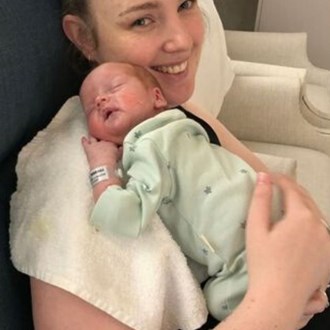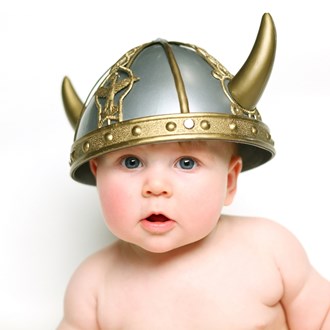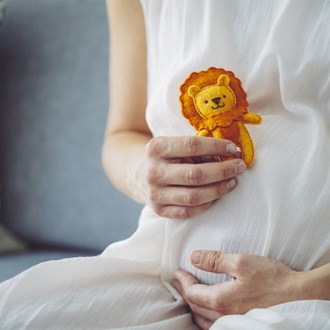How Much Stuff Does A Newborn Really Need?

So you’re prepared for your cuddly new housemate’s arrival..
By Megan Blandford
September 12 2016
Shops filled with baby equipment have overwhelmed many an expectant parent, but how much do you really need? And how organised do you need to be before bub is born?
First, it’s worth thinking practically about these first months of your baby’s life. As it turns out, the rumours are true: babies spend their days sleeping, feeding and filling their nappies. “Your baby’s primary needs are closeness, warmth and comfort, to be fed and have a safe place to sleep,” says Lois Wattis, midwife and author of New Baby 101 - A Midwife's Guide for New Parents (Complete Publishing, $24.99).
Once you realise that your baby needs surprisingly few things to fill those basic needs, you can head to the shops with a clearer idea of where to start buying what you need (and perhaps a few things you want, too).
And, as with many things in life, a little preparation goes a long way.
Sleeping like a baby
In these first months your baby will spend most of her time sleeping, so it’s worth thinking about where you want her during the night and for daytime naps. There are a few options for buying sleeping equipment, and your purchases will come down to a personal decision. “It depends on the parenting style you’re going to have, although you might not know this yet,” Lois says. Whichever options you’re considering, check out www.sidsandkids.org for more information on safe sleeping.
Cot
The most common choice is to buy a cot, ensuring it meets the current Australian mandatory standards. A cot can be placed in your bedroom (and this is the recommendation by SIDS and Kids for the first six to 12 months) or the baby’s own room, and it can last up to the toddler stage.
Bassinette
A bassinette has a shorter life span, as it’s only suitable for a baby who can’t roll or move around. If you’re buying a bassinette, be aware that safety standards are only voluntary, so you’ll need to do your research first.
Co-sleeping
If you’d like to keep your baby close, co-sleeping is a popular choice. There are ways to do this safely in your own bed, or you can buy a co-sleeping attachment for your bed. Lois says these are a good option: “The baby has her own zone but is right there within arm’s reach. Babies also often settle better when they’re in close range of mum or dad.”
Baby monitors
Once you’ve made a decision about your newborn’s sleeping arrangements, you might have a clearer idea of whether you’d like a monitor. Some parents find monitors helpful, especially if baby is in her own room, while others find them disruptive. Monitors can be as simple or as complex as you like; the main thing is that you’re aware of your baby’s movements during all those sleeping hours.
Blankets and bedding
When it comes to filling your baby’s sleep space, minimalist is your best bet. For safety, SIDS and Kids recommends avoiding any pillows, cushions, bumpers, toys or extra blankets. Stick with simple cotton wraps for your little one.
Feeding time
Some parents have a clear idea about whether their baby will be breastfed, bottle-fed or a combination, while others aren’t sure what to expect. So, do you need to buy anything ahead of time?
Breast pump
There are times when pumping breastmilk into a bottle is necessary: if you’ve been advised due to your baby’s needs, or if dad is taking over an evening feed, for example. It’s an individual decision based on you and your baby. If you’re not sure, you can always buy or hire a pump after baby is born.
Bottles
If you’re planning to bottle-feed wholly or partially, you’ll need some bottles, teats and sterilising equipment on hand, however try not to go overboard. “I discourage people from buying too much equipment,” says Lois, explaining that if you’re also breastfeeding then you may be advised to use a specific teat that’s less likely to interfere with this.
Cushions
While you can feed your baby anywhere, some parents find having feeding cushions and some good back support on hand can be helpful to their efforts.
Warmth and comfort
Nappies
Cloth or disposable? We’re going to sit on the fence here: the choice is yours! Either way, you’ll definitely need to have some on hand straight away.
Change table
Whether you choose to buy a change table or use a portable mat, it’s a good idea to be as prepared as possible. “One of the first jobs you’ll need to do when you get your baby home is change her nappy,” explains Lois. “Have the area set up, the packages open and ready to grab because there are bound to be some catastrophic disasters in the nappy zone at some point!”
Bathing equipment
A baby bath will be useful for the first few months. You’ll need to have some face washers and towels on hand, although you can use some of yours if you’d like.
Clothing
You’ll need a few grow suits for your baby, but you won’t need many. She’ll outgrow her newborn sizes before you know it, and it’s also likely people will gift her some clothes.
Out and about
Car seat
You have two main options for taking your little one in the car: a capsule (which you can easily move in and out of the car) or a rear-facing baby seat (which can convert to a front-facing seat later on). Either way, this is definitely something you’ll need to have bought and fitted ahead of time, so you can get your precious bundle home. You can find a good car seat safety guide on www.choice.com.au.
Carrier
Every parent has their preferred brand of baby carrier. Try some on for comfort, do your safety research, and think about what will suit your movements best. Other parents prefer to avoid carriers; it all depends on your lifestyle and parenting choices.
Pram
“Invest in a good pram,” suggests Lois. “The rocking motion is really good for getting your baby to sleep, and you can use the pram when you’re out or at home if you choose one that fits in the landscape of your house.”
Nappy bag
Getting out of the house with a baby can be tricky, so it’s great to have a bag packed and ready so you can grab it and go. Look for a bag that will fit your things in a way that makes sense to you, and is easy to use when your hands are full.






